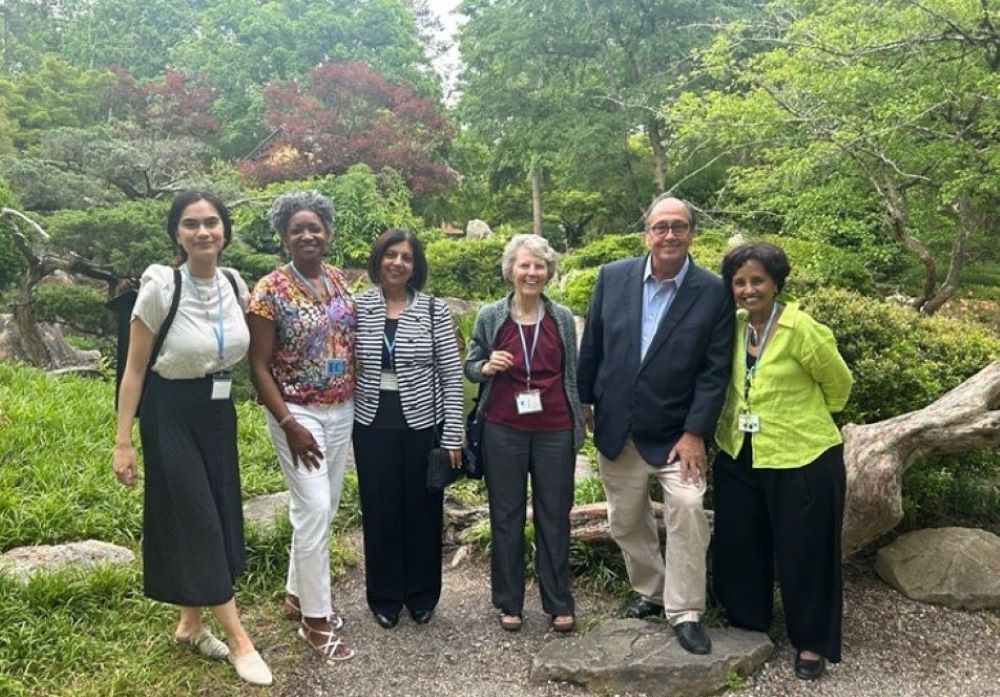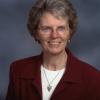
The board of directors for the Conrad N. Hilton Foundation gathered in Birmingham, Alabama, to discuss the board's equity fund. Sr. Joyce Meyer is third from right. (Courtesy of Shaheen Kassim-Lakha)
Pope Francis habitually calls us to seek out our neighbors on the margins of society and to always keep equity in mind — no one should be left behind. Conrad Hilton, in his legacy will and testament echoes Francis, encouraging Conrad N. Hilton Foundation board members to leave no one walking in darkness alone or considered unworthy of love or resources, nor allow distinctions of race, religion or territory. Love, he said, will bind all in one great family.
Equity is integrated into the strategic initiatives of the Conrad N. Hilton Foundation and is also called out through a distinct Equity Fund to more directly combat bias and injustice across multiple dimensions, including race, gender, disability, religion and sexual orientation. (The Conrad N. Hilton Foundation is a major funder of Global Sisters Report.) Recently, I had the privilege as a board member to be part of a unique gathering of executive leaders representing organizations working to ensure equity for many of our neighbors on the margins of society. The meeting, held in May in Birmingham, Alabama, a beautiful city with a predominantly Black population, where equity had been set aside for years and is famous for being a significant site of the Civil Rights Movement in our country.
To set the stage prior to the meeting, I had the privilege of spending several hours in Montgomery and Selma, not far from Birmingham, both striving to reclaim their histories and build new life. Montgomery has re-identified itself as the Capital of Dreams to recognize both the dreams of Martin Luther King Jr. and of a renewing city. Selma is on a similar path to revitalization, and initiatives can be seen everywhere.
Montgomery is the site of the Legacy Museum (2021) and the National Memorial for Peace and Justice (2018), initiated by Bryan Stevenson, founder of the Equal Justice Initiative. The museum is an amazing vehicle helping visitors experience the history of slave trade and slavery up to the present mass incarceration of Black men, women and even children that marks our country. It does so through a variety of media: animation, videos, wall displays and sculptures including jars of soil from lynching sites from many regions in our country.
Entering the museum, we were met by a wall video of wild Atlantic waves gushing toward us, reminding us of the thousands of chained African women, men and children who died at sea on their way to America from various west African countries. From there we walked into a large room of beach-like space where haunting ceramic faces were carved, exhibiting the fear and horror of their fate. Imagining these heads and shoulders rising out of the sea brought the reality of those past experiences into the present.
Holograms of incarcerated prisoners helped us hear the tragic stories of pain, loss and breakups of families as ghost-like figures of mothers and children held in solitary cells, separated by slave sellers and holders, pleaded for one another's life. Live actors' pleading, mournful voices helped us hear the pain and anguish, bringing to mind the separation of parents and children experiencing similar confinement and separation at our own southern borders.
It was an eerie feeling to walk into and out of spaces in the building where some of the atrocities of torture had taken place. Walls of jars filled with soil from counties in both north and south United States registered for me the reality of places where lynching happened. I thought so often of current global trafficking. The horrors of the past are not all past for hundreds of women, children and men today.
The inhumanity experienced through the visuals and sounds was challenging to absorb because they were so visceral. People around me were silently weeping and my own tears of grief and anger surged up strongly. There were many adults, school children and families quietly circling among one another. Eavesdropping on parents explaining to their children what they were seeing and hearing was also very moving for me. I wondered what these children were feeling being immersed in these experiences and what impact they would have on their future.
The section on mass incarceration was especially distressing. In this section, there was an opportunity to enter a staged prison booth, with glass separating visitor from prisoner, and through a telephone receiver, listen to a real inmate's story. These were women, men and youth frequently incarcerated to serve extraordinarily long terms for writing a bad check or being caught with a joint of marijuana, or a Black man accused of looking at a white woman or carrying a picture of one. It was truly painful absorbing the truth of such actions of injustice. Pictures of large rooms filled with bunk beds filled with children and young boys warehoused in prisons with shortage of space, sometimes for life sentences, was more than heartbreaking.
One section focused on interracial marriages: the psychological and even physical suffering of being beaten and discriminated against and even imprisoned because a man or woman loved each other. I could only imagine what must be happening to LGBTQ couples in our day suffering similar indignities.
The National Memorial for Peace and Justice made the lynching part of our national history very graphic. The number of hanging tombstones titled with state counties, from both south and north carved with the names of persons lynched — women, men and children — was shocking. Six acres are dedicated to helping us recognize and take responsibility, not only for the past, but for systems and laws still in place that deny human rights and even continue atrocities against persons different from ourselves. Where is our freedom and justice for all?
What was astounding to me as I spent those hours witnessing and listening to the voices that cried out for mercy and justice was the courage of those who defied the laws and cultures of violence, willing to give up their own lives to make people aware of what was happening and taking actions to counter it. We hear of the most famous, but I learned of many unsung activists who were part of the movements to end discrimination and slavery.
The executives of the 28 organizations, Hilton partners in equity issues, bear similar banners and made me so aware of hope and resiliency. These groups continue to struggle to change systems that keep people isolated and imprisoned, not only by prison bars but by unjust laws and cultural attitudes of superiority. On our way to the equity meeting, we walked part of the 54 miles "on the road to Montgomery," remembering the women religious who were there.
To set the context for the meeting, Community Science's vice president of consulting, Kien Lee, presented the history of the Hilton Equity Fund, its purpose and principles and its evolution since 2018. Lee also spoke about some challenges these organizations face, including society push back that can threaten safety and security, strategic thinking about future funding when grants conclude, partnering with other groups to support social change and not harm ecosystems. She also reported successes, encouraging the groups to help support each other.
Of the 28 organizations, I only found the opportunity to talk with 15. There was extraordinary diversity of communities served: racial, ethnic, faiths and interfaith, LGBTQ+, gender and youth, civic engagement, conveners of similar organizations and even investigative journalism. Each executive was inspiring as many of them had personal experience of being one of the group of persons they now serve.
Eddy Zheng, founder and president of New Breath Foundation, an immigrant from China, was incarcerated for 20 years from age 16 and endured a year in solitary confinement for advocating for education for prisoners in Alcatraz. Eventually, through help from advocacy groups, he was paroled and gained freedom. He immediately began a foundation helping other Asians who he says are always considered "other" because they are not white, Black or Hispanic.
Connie Wun, a former sex worker, earned a doctorate, became a writer, editor and founder of AAPI Women Lead to end violence against Asian, Native Hawaiian, Pacific Islander women and girls, as well as non-binary communities. Lynn Faria, executive vice president at SAGE, works with elderly gay and transgender people in nursing homes, many of whom are isolated from others if known to have HIV/AIDS. The desire of these groups to work together to help protect and promote dignity and freedom was palpable.
These few days made me viscerally aware of what "intractable" means. The historical threads of violence woven into our society are sad and frustrating. If we truly want to build a more just and safe nation, it is imperative, as many have said, that we have a national facing of our destructive past and its influence on our present and future so we can move ahead. I recently heard a Jewish theologian speak about repentance as taking a new path — admitting the wrong or evil done, but letting go of negative blame and guilt, and instead choosing a new path. Do we have the will for this as a nation?







